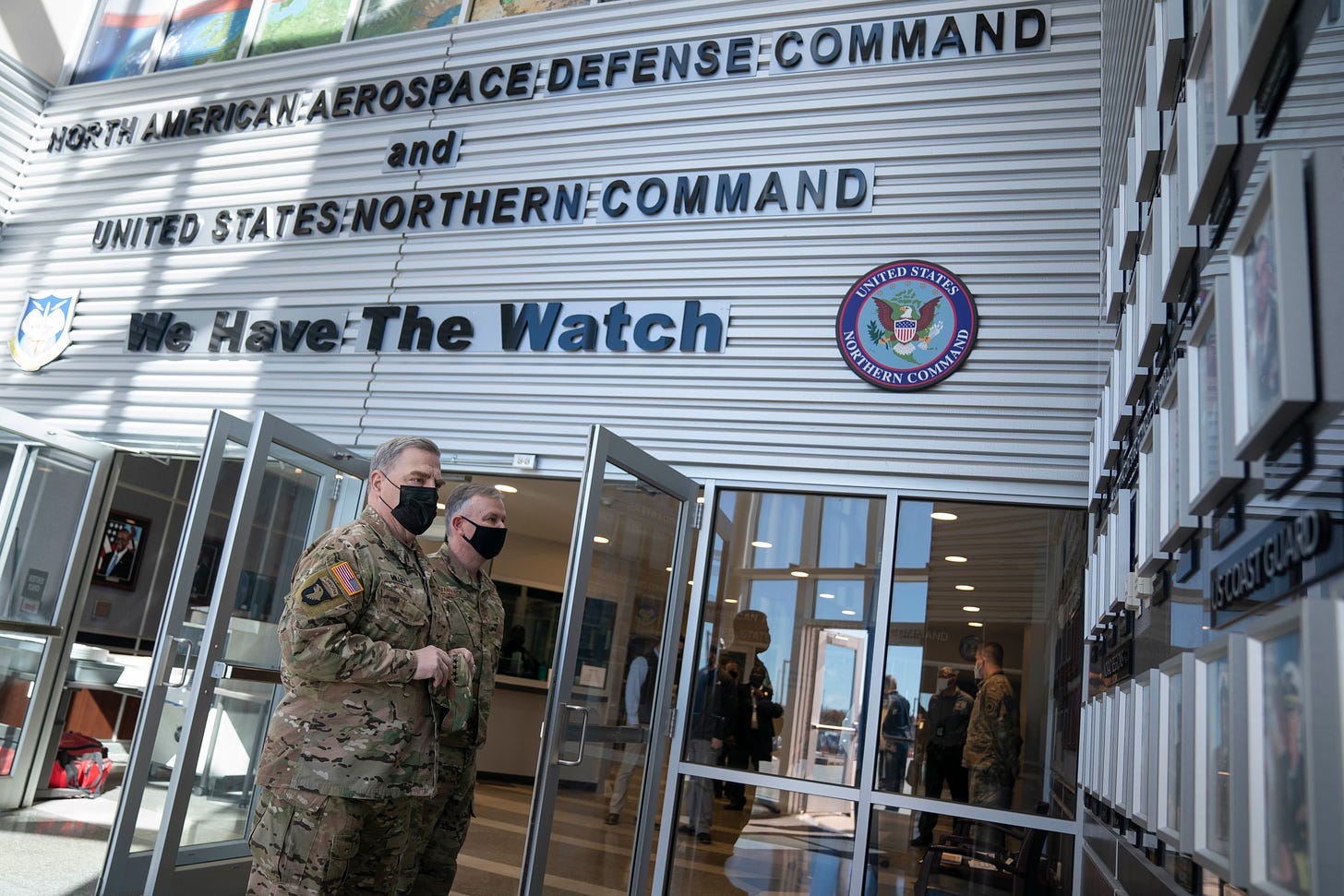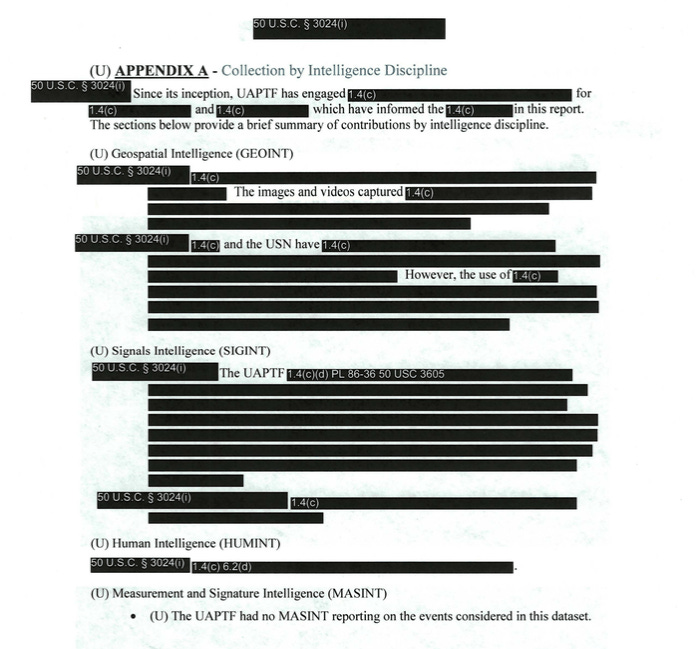Senators Requested NORAD, Others Answer Questions in Closed-Door Briefing Following UAP Report Last Year
NORAD and other military and intelligence entities were requested by the Senate Select Committee on Intelligence to answer questions behind closed doors last year on unidentified anomalous phenomena.

New documents released by the Pentagon are shedding light on some of the government and military entities that have been engaging with Congress behind closed doors on the issue of unidentified anomalous phenomena (UAP), including an organization that was not included in the Office of the Director of National Intelligence’s June 2021 Preliminary Report: Unidentified Aerial Phenomena.
According to a document released to the UAPR by the Office of the Undersecretary for Defense (Intelligence & Security), members of the Senate Select Committee on Intelligence (SSCI) requested a closed-door meeting related to the ODNI’s report to which Pentagon officials were asked to attend in July of last year. The 33 pages that were released by the OUSD (I&S), nearly all of which are redacted, are in response to a Freedom of Information Act request filed by the UAPR for records exchanged between OUSD (I&S) and all Congressional offices regarding UAP and related matters from August 1, 2020 to February of 2022. The UAPR has since filed an appeal to gain access to more documents.
Mere days after the ODNI’s highly-anticipated report on UAP was released, a June 29, 2021 letter was transmitted from the offices of SSCI Chairman Mark Warner and SSCI Vice Chairman Marco Rubio to Ronald Moultrie, the Undersecretary of Defense for Intelligence and Security (below). The committee requested that Neill Tipton, Director of Defense Intelligence (Collections and Special Programs) at the OUSD (I&S), attend the briefing with representatives from the ODNI, the Department of the Navy, the Department of the Air Force, and U.S. Northern Command J3.
The SSCI requesting Tipton’s attendance is likely significant primarily because of his over three decades of experience in signals intelligence (SIGINT) and geospatial intelligence (GEOINT) collection and analysis—in other words, the types of intelligence sourcing contained in the Unidentified Aerial Phenomena Task Force dataset alluded to (below) in the ODNI’s partially declassified report obtained and made public by the government document archive site The Black Vault. The UAPTF was a precursor to the Pentagon’s current UAP office, the All-domain Anomaly Resolution Office, or AARO, which was officially launched in July.
According to the OUSD (I&S) letter released to the UAPR, the SSCI called for the closed-door briefing with Tipton and representatives from military commands so that members could pose a series of questions regarding the ODNI’s preliminary report. While the exact nature of those questions remain unknown, “…you can probably infer a lot by the contours of the legislative proposals that emerged not long thereafter, on both the House and Senate sides—most of which became law,” Douglas Dean Johnson, a private researcher who writes extensively on UFO-related activity in the legislative and executive branches, told the UAPR.
A spokesperson for a Senator on the Select Committee on Intelligence declined to comment for this story.
Those proposals eventually led to wide-ranging and substantive legislation signed into law by President Joe Biden this month. Contained within the National Defense Authorization Act for fiscal year 2023 are landmark provisions that provide protections from prosecution or retaliation for government employees or private contractors with knowledge of programs related to UAP and who wish to come forward and securely share information with Congress or the AARO, regardless of any nondisclosure agreements personnel may have signed in the past.
Additional provisions mandate a far-reaching historical review of government documents by the AARO related to UAP dating back to 1945, as well as a review of all nondisclosure agreements within the intelligence and defense communities.
“This is arguably the biggest story mainstream news organizations have ever failed to cover,” Christopher Mellon, a former Minority Staff Director of the Senate Intelligence Committee and also former Deputy Assistant Secretary of Defense for Intelligence, wrote in a statement after President Biden signed the NDAA into law.
You can check out D. Dean Johnson’s excellent and extensive analysis of the provisions here.
While the Air Force, Navy, and OUSD(I&S) have more or less been in recent news media coverage pertaining to UAP, NORTHCOM arguably has not. The unified combatant command, founded shortly after the terrorist attacks of September 11, 2001, is primarily tasked with defending the continental United States and providing very limited operational support for civil authorities in certain domestic emergencies, such as the Deepwater Horizon disaster in 2010. In 2002, over a dozen federal agencies had a presence at NORTHCOM, including the National Geospatial-Intelligence Agency (NGA), the Federal Aviation Administration (FAA), and the National Aeronautics and Space Administration (NASA), according to the New York Times.
While those agencies certainly are germane to the topic of UAP—all three were listed as contributors to the ODNI’s inaugural report on unidentified anomalous phenomena—so is NORTHCOM, as it oversees the North American Aerospace Defense Command (NORAD), which certainly has its own history with the phenomenon.
Gen. Glen D. VanHerck, who assumed command of NORTHCOM and NORAD in 2020, is publicly adamant that NORAD does not track anomalous phenomena in the nation’s skies and in low Earth orbit.
"First of all, let's be clear. My job as the NORAD commander is to identify every single UAP or ... whatever it is,” NORTHCOM commander Gen. VanHerck said in July at the Aspen Security Forum. “What I would report to you is I've yet to find one that had aliens or was a spaceship that we've identified. If any of our NORAD fighters, or any assets assigned to NORTHCOM, came across some type of UAP, we would absolutely report that. I'm just telling you, we haven't seen that."
However, NORAD has publicly admitted to scrambling Air Force intercepts in response to unidentified objects observed by commercial aircraft and the Federal Aviation Administration. It also disclosed in 2015 that it detects hundreds of anomalous “Tracks of Interest” annually, including unknowns (see the document above)—admittedly all of which occurred before VanHerck assumed command. While many of those incidents are eventually resolved as identified, some certainly are not.
Coupled with the fact that Congress invited NORTHCOM to answer questions on UAP in the wake of a report prepared by America’s intelligence services—in which the overwhelming majority of reported anomalous military encounters were unexplained at the time—Gen. VanHerck arguably may know more than he is letting on. What that is, however, remains a mystery for now. It also remains to be seen what the public will learn from the Congressionally-mandated Director of National Intelligence report on UAP which was due on October 31, yet remains under wraps—unseen even by the Congress that demanded it.
The UAPR has filed an appeal to the OUSD(I&S) response and will update this story as necessary.






